The Future Alternative Past: now with animal pictures
Every month, Nisi Shawl presents us with news and updates from her perch overlooking the world of science-fiction, fantasy, and horror. You can also look through the archives of the column.
Dog stars
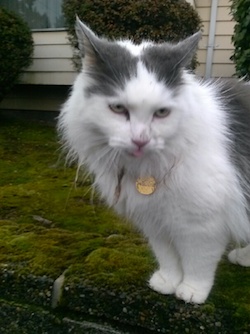
Like so many writers, I have a cat. Minnie’s her name, and she’s pretty punk. But it’s the dog I didn’t get instead of Minnie I’ve written stories about, and it’s dogs in stories I’m writing about here.
First title in the Table of Contents for my imaginary SFFH reprints anthology About a Dog is Bradley Denton’s fabulous “Sergeant Chip,” winner of the 2005 Theodore Sturgeon Memorial Award. Chip, the technologically-enhanced K9 (canine) soldier, narrates a war-time encounter that calls into heart-twisting question his doggish loyalties.
Next would come Kelly Link’s “The Hortlak.” Which maybe isn’t about a dog at all. Dogs are in it. But so are zombies and pajamas. A protagonist working in a convenience store near the “Ausible Chasm” (a zombie point source), yearns after an animal shelter worker who treats the dogs she euthanizes to pre-injection car rides. Just your typical Kelly Link story, and more an exploration of doggishness than of dogs. I still want it.
Connie Willis’s Hugo and Nebula award-winning “The Last of the Winnebagos” would be in there, too. It is clearly and certifiably about dogs — though more specifically it’s about their absence in the wake of a devastating plague, and the lengths people go to so they can hold onto the special relationship we’ve formed with dogs over the last few thousand years.
I’d also need to include some version of Harlan Ellison’s brutal, elegant, and arguably misogynistic “A Boy and His Dog.” That’s the story of 15-year-old Vic and his telepathic canine partner Blood, scavenging their way across a post-nuclear holocaust wasteland. Then, as a restorative, I’d add one of Michael Swanwick’s tales of professional ne’er-do-wells Darger and Surplus. Though Swanwick describes Surplus (full name Sir Blackthorpe Ravenscairn de Plus Precieux) as a bipedal talking dog dressed like a refugee from Mother Goose, he originates in the far-future demesne of Western Vermont, a product of “the gene-mills of Winooski.” For actual fantasy I’d turn to J.K. Rowling’s Harry Potter series and excerpt a Hagrid/Fluffy scene or two. You remember Fluffy, the three-headed Cerberusesque guardian of the Philosopher’s Stone, right?
Should I likewise excerpt a dramatic passage from Stephen King’s Cujo? I’ll have to read it to find out.
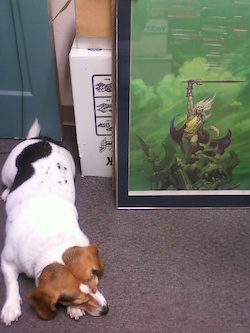
Could be reprinting my own canine horror story would be easier to arrange. “The Tawny Bitch” combines a spectral dog with references to Charlotte Perkins Gilman’s feminist classic “The Yellow Wallpaper” and the recently discovered luridly sensationalist fiction of Louisa May Alcott (kidnapped heiresses! murder! opium!). On the other hand, maybe I’d want to reserve myself a spot instead for “Black Betty,” my talking dog story and homage to one of the smartest, bravest, sweetest Beagle mixes I’ve ever known.
The funnest part of compiling this imaginary anthology would be tying together these very disparate stories — stories differing in subgenre and style and the extent of their engagement with dogs and dogness — with an introduction. Or an afterword. Or both. I’d write about our longest running attempt at interspecies communication, and about the experiments in which we killed Laika and countless, nameless others of our so-called best friends. About the knowledge we’ve won and shared together, and the wisdom yet to come.
Recent books recently read
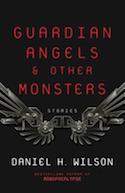
No one better conveys the thrill of technology’s advance than Daniel H. Wilson, author of the NYT bestseller Robopocalypse and the nonfiction guidebook to an imagined future Where’s My Jetpack? Guardian Angels and Other Monsters (Vintage), a new collection of Wilson’s short stories, showcases his loving ambivalence toward Artificial Intelligence’s potential in particular. Which will we encounter in years to come: the indomitably loyal AI nanny foiling its charge’s kidnapper in “Miss Gloria?” The wide-eyed, impressionable student of “Jack, the Determined?” Or the pitiless soldier-highjackers of “Parasite?” Fast-paced and vivid,Wilson’s takes on these possible scenarios seem simultaneously surprising and inevitable, even as they contradict one another. There’s a depth of feeling arising from the different perspectives he provides: peeking through them, poking around behind, we get a good sense of the endless layers awaiting us in all his work.
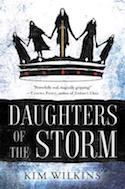
Daughters of the Storm (Del Rey) by veteran Australian author Kim Wilkins begins a saga-like series about a royal dynasty ruling a realm reminiscent of the setting for Beowulf. Magic is real, and cares very little whether it’s also clean, convenient, or fair. Five sister princesses struggle for power when a mysterious spell strikes down their father: Bluebell, a born warrior, battles those she suspects of foul play with sword and armor, while Ash apprentices herself to a murderous shapeshifter to learn enchantment’s ways, and Rose weds and then betrays the monarch of a patriarchal neighboring land. The two youngest girls, Ivy and Willow, are the least family-minded and also (not coincidentally) least likeable of this bunch, but even they come across as totally fascinating and believable, thanks to Wilkins’s talented tale-spinning — though I must admit it’s Bluebell who truly won my heart.
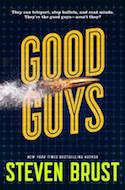
Steven Brust’s Good Guys (Tor) leaves behind the vaguely 16th century milieu of his bestselling Vlad Taltos books for modern times. The novel moves from plot point to plot point in the comforting rhythms of a classic thriller, as super spies investigate their organization’s infiltration by baddies. But these super spies only earn minimum wage and supplement their espionage with data entry work. The fact that they’re also trained as magicians does nothing to undermine the necessity for that, and nothing to ensure they’ll win. After all, the bad guys use the same magic. Combining the suspense resulting from this situation and the characters’ ironic commentary, the prolific Brust has written yet another highly enjoyable read.
Couple of upcoming cons
Originally located in Edgar Allen Poe’s hometown of Richmond, Virginia, Ravencon now offers attendees its panels, tournaments, workshops, readings, concerts, movies, and charity auction in Williamsburg, 50+ miles east. With four Guests of Honor — Gaming, Music, Art, and Author — Ravencon emphasizes multiple SFFH modalities while staying true to that ancient con philosophy: the community that geeks together fleeks together. Or words to that effect.
Not far off, in Washington, D.C., the USA Science and Engineering Festival will provide a free weekend’s access to nerd heaven. Pavilions focused on space flight, robots, secret codes, and a wealth of other mind-melting fields of knowledge will entertain participants between stage shows put on by an “explosive chemist,” a “stunt scientist,” and a gentleman respectfully referred to as “Mr. Freeze.” If all this sounds a bit PG-13, that’s deliberate: kids are the Festival’s target audience, though we curious adults are not excluded.